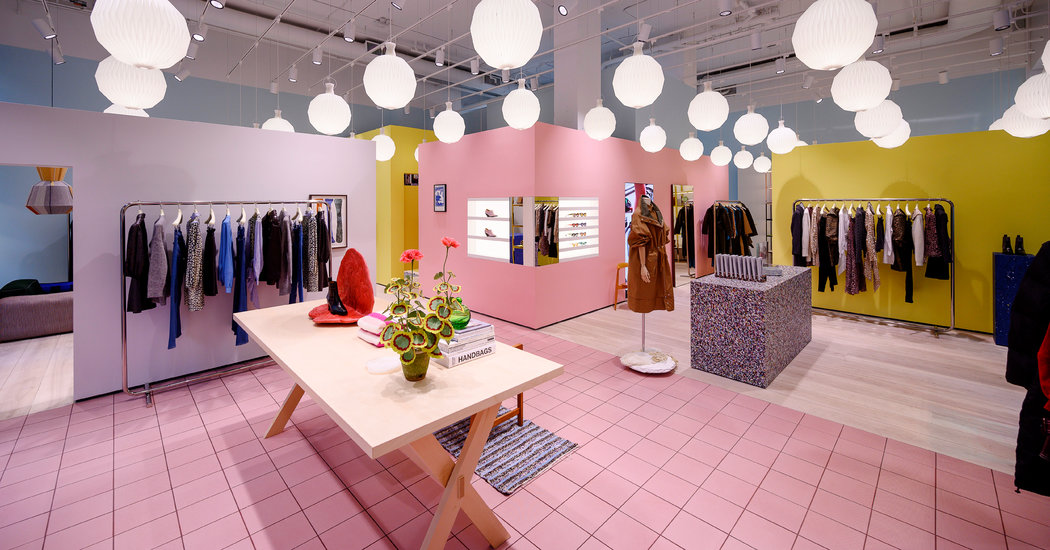
According to the 2019 World Happiness Report, Denmark is the second happiest country in the world. I was the second happiest shopper inside the Ganni store in SoHo, the first stateside location for the Danish brand that has found a huge number of fans in the United States. (A second has just opened in Los Angeles.)
It’s a street-style magnet that has slowly built a big social presence. The clothes are buoyant and colorful. They look happy, even life giving.
“I am so excited you opened!” That was the happiest shopper inside Ganni. She walked in and hugged a rack of clothes as if she were a young girl embracing her favorite influencer after standing in a 1,000-person line. “It’s in real life,” she said. It feels too good to be true.
Ganni is known for piloting an aesthetic its founders call Scandi 2.0, a look defined by its kooky mix of colors, textures and forms that look beautiful in the way you would expect a tot’s scribble in a Scandinavian gender-neutral preschool to be beautiful: They represent a principle of thinking, born not just of one artist’s joy but from a society’s joy.
Ganni is bright, it’s demure, it’s flouncy, it’s lean, it’s a wrong-right minimalist mishmash.
You don’t need a history of Scandinavian design and politics that I assembled from other people’s academic work like an ethically composed metallic silver, brown leather and tortoiseshell handbag ($620) to think about this along with me. Working from the vague sense of what Scandinavian design represents to you is the point.
Before I went to Ganni, I looked up Denmark’s Gini coefficient, a statistical measure used to gauge economic inequality. (Denmark is consistently among the top three in world rankings.) In the store I saw bold sans-serif “GANNI” on the hang tags, on sweatshirts and even on a laptop case, and in my peripheral vision I kept mistaking it for “GINI.”
The walls of the Ganni store were intensely saturated in a palette from a bag of saltwater taffy, yet somehow the place was decorated with extreme reserve. Slices of red, purple and orange felt so bright that they made Jell-O look sun bleached were stacked into a couch.
Above it hung a single green ceramic plate and a framed photograph of a woman peeking out from behind the wall of her own hand. They were off-center on the wall, but to gaze upon them together made one feel centered, because aren’t we all a little off? But we still look great?
Scandi 2.0 has some higgledy-piggledy hygge. I tried on a gigantic camel puffer coat ($505). Its faux down mounds made me feel vaguely loved. I tried a gray high-neck hooded sweater with drawstrings (called a Hoodi on the tag). Its delicate sloping hood settled around my face in the shape of cathedral. It was heavenly.
Pants made of fabric like iridescent pond water ($280) made my legs look the longest they’ve ever looked. When I took them off, I was surprised how much I liked the fabric inside out, and so I tried them on that way too. They worked.
Am I a #gannigirl? I feel more than a little off. I do not look great.
It seems much more appealing to be a #girl who lives in a democratic socialist country, gets paid to have children, paid to take leave from work and raise them for however long they get — 15 years? Who doesn’t want to wear a pleated skirt to the doctor and be seen on two levels: by a medical professional and by fellow cared-for people who have the mental space to notice that you look cute!
Who doesn’t want to trust their government, sing carols in a rainbow sweater ($395) and wear a crown of wildflowers with your three-quarter puff sleeve leather trench? Who doesn’t want to live in a world where buying new clothes can be fun and still remotely ethical thanks to true sustainable practices? Put 80,000 Ganni silk scrunchies between myself and reality. Ganni grants wishes. Gini in a bottle.
There’s something unsettling. Dressing like a person who lives in a happy society feels completely deranged.
Ganni recommends avoiding conflict. I tried on a wrap dress ($250) with a tag warning about delicate fabric: “It is recommended that you do not wear sharp or pointed jewelry.”
The fabric was beautiful, black with blocky lines like ice floes. Though the dress was low cut, it was still somehow dowdy. In fact, despite the mix of materials and ideas in Ganni pieces, the deep cohesion eliminates any sense of perversion or even personal style. Fully integrated difference becomes sameness.
Wearing Ganni in New York occupies a previously unimaginable sliver of Venn diagram wherein one can look like a socialite who socializes with socialists.
What’s the secret?
“It’s not just like we’re particularly great at dressing,” Nicolaj Reffstrup, the chief executive of Ganni, told Glamour last year. It’s a matter of “attitude” he said, and of living in one of the most well-balanced places left on earth, and “that injects self-confidence and attitude.”
I am not a #ginigirl. I am an American in Scandi clothes, and I am not happy.
Ganni
40 Mercer Street; ganni.com
Vibe The recycled rainbow plastic reception desk has a sculpture on it of scrunchies encased in Lucite. Is this a store for grown-up VSCO girls?
Pricing Lower than much of contemporary fashion, but I felt myself wanting a lining in coats and dresses.
Merchandise Wide wale corduroy, cheetah prints, pearl fringe and purple-dyed denim all share a rack, yet somehow #GANNIGirls all look similar.







